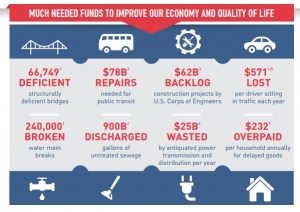
America’s infrastructure is crumbling – our roads, bridges, schools and water plants. While government officials are eager to address these growing needs, funding sources are scarce.
There is an alternative solution to paying for infrastructure projects with funding other than local, state and federal allocations. But, according to a report released this week by the Bipartisan Policy Center (BPC), Bridging the Gap Together: A New Model to Modernize U.S. Infrastructure, the solution will require a culture change.
 The report supports increasing public-private partnerships (P3s/PPPs) and private capital to meet infrastructure needs. In a discussion earlier this week as part of Infrastructure Week nationwide, a panel of former elected and appointed government officials agreed that P3s are an attractive option that should be considered for at least half of the capital that will be required. The funding gap for infrastructure needs is $3 trillion.
The report supports increasing public-private partnerships (P3s/PPPs) and private capital to meet infrastructure needs. In a discussion earlier this week as part of Infrastructure Week nationwide, a panel of former elected and appointed government officials agreed that P3s are an attractive option that should be considered for at least half of the capital that will be required. The funding gap for infrastructure needs is $3 trillion.
Henry Cisneros, former San Antonio mayor and previous Secretary of the U.S. Department of Housing and Urban Development, was part of the group involved in the discussions. Cisneros urged greater use of public-private collaborations, calling infrastructure the future of economic development, without which the United States will begin to fall behind other countries. Panelists stressed that the collaborations will not only improve the health, safety and security of communities, but create millions of jobs and lead to a prosperous future for the country.
The infrastructure report points out that while emerging technology and innovation can play a key role in maintaining, expanding and improving the nation’s infrastructure, it cannot do so successfully without engaging private capital. Interestingly enough, the private sector stands ready with available cash, expertise and a willingness to commit to long-term investments.
The report proposes a new model for bringing the public and private sectors together in an environment in which regulatory impediments and lack of data are no longer hurdles that discourage private investment. The new model will result in quicker completion of projects, better quality projects and improved return on investment.
The report defines the core principles of the new model as being:
- No projects proceed until the public benefits of each are identified and clearly stated;
- Investment decisions not only will incorporate upfront costs, but also a full life-cycle evaluation;
- Transparency is critical – the project benefits, costs and risks are accounted for and made public;
- There is a comparison given of the risk of not investing in a project and the cost of taking action; and
- Both the public and private sectors share risks, costs and benefits.
The goal is for the model to encourage domestic private-sector investment and to be successful in attracting more global capital. Frightening figures project a dire result if culture change does not occur and if government entities do not move quickly to invest in the nation’s infrastructure. If projections are accurate and infrastructure needs are not met by 2020, the nation stands to absorb $1.2 trillion in increased business costs, lose $3.1 trillion in gross domestic product, incur $611 billion in additional household costs and face 3.5 million fewer jobs. Not a result any citizen wants to imagine.
SPI’s team of government procurement consultants are experts in public-private partnerships. Contact them today.
